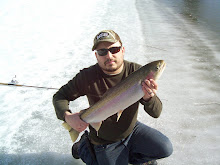Low Ball Stonefly
This pattern is one of my favorites out there it rides low in the film of the water. Often when the stones have been on for a couple days and flyfisherman have pounded a lot of high riding patterns in the river. i will throw on one of these or another pattern that rides low in the surface film of the water. I almost can say i prefer to fish these over say your sofa pillows and other high ride flys because they normally always float how they are suppose to bottom down. give it a shot and see what you think. FISH ON!!!!!!| HOOK: Dai Riki 270, size 2-8 THREAD: Hot orange 6/0 Uni-Thread EGG SAC: 3-4 wraps of black Haretron BODY: Orange sparkle dubbing OVERBODY: Gray foam RIBBING: Hot orange thread overlaid with orange KrystalFlash UNDERWING: Gray synthetic fly wing OVERWING: 6-8 feathers of natural CDC HEAD: Blended gray squirrel and orange sparkle dubbing LEGS: Black Super Floss |  |
Uses
Imitates the adult form of the salmonfly (Pteronarcys californica), also known as the giant stonefly.
The Low Ball Stonefly floats very low in the surface film, like a trapped natural, but the thick CDC wing and foam back ensures that it doesn't sink. With the exception of the CDC wing, it is a flat bug. If you look at it from underneath you'll see why it is so deadly: the silhouette is a near-perfect match of the natural.
Variations
A golden stonefly adult can be imitated with a slightly smaller hook and yellow dubbing for the body.
How to Fish
Stoneflies emerge on land, so adults are not available to trout when the hatch. But they spend several weeks crawling aroun in bankside vegetation looking for a mate. As the day warms up, the adults become active, and in their search for love they are often blown or fall out of overhanging vegetation. Once on the water, they either drown or are eaten by trout (let this be a lesson to you). So the best places to cast a salmonfly imitation are near the bank just downstream or downwind from overhanging vegetation. The river should be 2-4 feet deep, and if it has a rocky, bouldery bottom, so much the better. Use standard dry fly presentations
Near dusk, females salmonflies often gather in hoards, then drop to the river to lay their eggs. This is another fishing opportunity that should not be missed.
Because the salmonfly hatch is so popular with anglers, trout get pounded and soon become wary. A downstream presentation often works best in these circumstances.
Tying Instructions
1. Tie in thread and bring it to the rear of the fly.
2. Tie in gray foam, POINTED FORWARD. You don't want to tie it for the body and pull it back over because that will make the body too thick and expose too much of the orange body. Trim the excess at the rear of the fly. You can leave a small stump because the egg sac will cover it.
3. Add a tiny drop of Elmer's superglue at the tie-in point of the foam. This prevents the foam from spinning around the hook shank. Let dry (Elmer's dries the fastest).
4. Dub a small black egg sac with black sparkle dubbing.
5. Tie in KrystalFlash ribbing. Advance fly towards the head.
6. Make a thin body of orange dubbing from the FRONT to the BACK of the body. It should be thin, as you want the gray foam to go around the sides of the body.
7. Pull foam down, ribbing first with the thread and tying off. Then wrap the KrystalFlash over the thread wraps. The reason for two ribbings is that the KrystalFlash is not strong enough to hold the foam down when a trout is chewing on the fly. If the KrystalFlash breaks, you lose the ribbing and the fly looks weird to you and the fish.
8. Tie in synthetic wing material. Trim to shape.
9. Tie in 6-8 CDC feathers. It is not necessary to have them as long as the wing. I kind of like them dense and about the same length as the body.
10. Dub a small head.
11. Tie in short pieces of black Super Floss for legs.
12. Whipfinish and you're done. Once you get the steps down, pre-cut the wing material and legs, and sort the CDC feathers, this fly actually ties quite faster than the traditional Stimulator.

